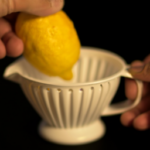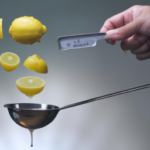Juice Tips and Tricks
How Much Juice Is Half A Lemon

In the world of cooking and baking, lemon juice is essential for adding flavor and acidity to many dishes. But you may be curious, how much juice can you get from half a lemon? On average, you can expect to get about 1 to 1.5 tablespoons of juice from half a lemon, depending on its size and ripeness. This information is helpful when following recipes that don’t specify an exact amount, leaving you wondering *how much juice in half a lemon* is required. To maximize the juice, it’s always a good idea to roll the lemon on the counter before slicing it.
The answer to this question isn’t as straightforward as it may seem, as there are several factors that can affect the yield of lemon juice. Firstly, the ripeness of the lemon can impact how much juice it contains. A fully ripe lemon will be softer and juicier than an underripe one, so if you’re looking to extract the maximum amount of juice, it’s best to use lemons that are fully ripe.
Additionally, the type of lemon you’re using can make a difference – some varieties, such as Meyer lemons, tend to be juicier than others. In this article, we’ll explore the various factors that can affect lemon juice yield and provide tips for getting the most juice out of your lemons.
Key Takeaways
- The amount of juice from half a lemon is affected by factors such as ripeness and type of lemon.
- Fully ripe lemons and Meyer lemons tend to yield more juice.
- Using a citrus press or handheld juicer is a quick and efficient way to extract lemon juice.
- Rolling the lemon before juicing it and microwaving it for a few seconds can help to extract more juice.
Factors Affecting Lemon Juice Yield
When it comes to squeezing the most juice out of a lemon, the ripeness of the fruit and the pressure applied are two factors that can greatly affect the yield. The acidity level of the lemon also plays a role in the amount of juice produced.
If a lemon is too ripe, it may be too soft and difficult to extract juice from, resulting in a lower yield. On the other hand, if a lemon is not ripe enough, it may not have enough juice to extract. It’s important to find the right balance.
Another factor to consider is the pressure applied when squeezing the lemon. Too much pressure can result in bitter flavors being released, while too little pressure can result in lower juice yield. It’s important to find the right amount of pressure to release the most juice.
With these factors in mind, let’s explore some tools for extracting lemon juice.
Tools for Extracting Lemon Juice
Using a citrus press or handheld juicer is a quick and efficient way to extract the tangy goodness from a fresh lemon. These tools are widely available in kitchen stores and online shops, and they come in various sizes and designs. Here’s why using a lemon juicer is a good idea when making lemon juice:
- It separates the juice from the pulp and seeds, ensuring that you get a smooth and clear liquid.
- It maximizes the yield of juice, as it exerts more pressure on the fruit than manual squeezing.
- It reduces the risk of injury, as it requires less force and strain on your hands and wrists.
- It saves time and effort, as it allows you to juice multiple lemons in a matter of minutes.
If you don’t have a citrus press or handheld juicer, you can still extract lemon juice using other methods, such as manual squeezing, grating, or blending. However, these methods may not be as effective or efficient as using a specialized tool. Additionally, you can explore using alternative citrus fruits for juicing, such as limes, oranges, or grapefruits, which offer different flavors and nutritional benefits.
When it comes to extracting lemon juice, there are various ways to do it depending on your preferences and needs. One method is to cut the lemon in half and then use a lemon juicer to press down on the flesh. Another method is to grate the lemon zest and then squeeze the juice out of the pulp. A third method is to blend the lemon segments with water and strain the mixture through a fine mesh sieve.
Regardless of which method you choose, make sure to use fresh and ripe lemons, and avoid using the white pith or seeds, which can impart a bitter taste to the juice.
Step-by-Step Guide for Extracting Lemon Juice
To get the most zing out of your lemons, you gotta roll them like a boss before cutting them open. This simple method involves pressing the lemon on a flat surface with the palm of your hand and rolling it back and forth a few times. This helps to break down the membranes inside the lemon, making it easier to extract the juice.
Once you’ve rolled your lemon, it’s time to cut it open and extract the juice. There are several alternative methods for doing this, such as using a fork or a citrus squeezer. However, I prefer to use my hands as they allow me to control the amount of pressure I apply, ensuring that I get as much juice out of the lemon as possible.
If you’re out of lemons or simply prefer not to use them, there are also several lemon juice substitutes available that can still give your dish that tangy flavor. However, nothing beats the fresh, zesty taste of real lemon juice.
In the next section, I’ll share some tips for getting the most juice out of your lemons without wasting any.
Tips for Getting the Most Juice out of Your Lemons
When I’m trying to get the most juice out of my lemons, I have a few tricks up my sleeve. First, I always give the lemon a good roll on the countertop before cutting it open. This helps to break down the membranes inside the fruit and release more juice.
If I’m really struggling to get juice out of a particularly stubborn lemon, I’ll pop it in the microwave for 10-15 seconds to warm it up.
Finally, if all else fails, I’ll heat the lemon in a pot of hot water for a few minutes to really get the juices flowing.
Roll the Lemon
Rolling a lemon before juicing it can help release more juice and make it easier to get half a lemon’s worth. The benefits of rolling lemons include breaking down the lemon’s fibers, which helps to release the juice. By doing so, it is easier to get more juice from the lemon. Techniques for squeezing lemons by hand can also help to extract more juice. One way to do this is to cut the lemon in half and use a citrus squeezer. Another way is to use your hands to squeeze the lemon, making sure to apply pressure evenly to get the most juice out.
To visualize the benefits of rolling a lemon, imagine a lemon with its fibers running vertically from top to bottom. When you roll the lemon, you are breaking down these fibers, making it easier for the juice to flow out. The table below summarizes the benefits of rolling a lemon and the techniques for squeezing lemons by hand.
| Benefits of Rolling Lemons | Techniques for Squeezing Lemons by Hand |
|---|---|
| Breaks down fibers | Cut the lemon in half and use a citrus squeezer |
| Releases more juice | Use your hands to squeeze the lemon |
| Easier to get juice | Apply pressure evenly to get the most juice out |
| Less waste |
Microwaving the lemon for a few seconds before juicing can also help to extract more juice.
Microwave the Lemon
After rolling the lemon to break down its membranes and make it easier to extract juice, one efficient way to get the most out of this citrus fruit is by microwaving it. Microwaving techniques have become increasingly popular for lemon juice extraction methods as they save time and are more convenient compared to other traditional methods.
To start, cut the lemon in half and place it in a microwave-safe dish, cut side up. Heat it in the microwave for 10-20 seconds, depending on the wattage of your microwave. The heat will break down the lemon’s cell walls, making it easier to extract the juice.
Here are five reasons why microwaving the lemon is a great option:
- It softens the lemon, making it easier to extract juice.
- It also makes it easier to remove the lemon seeds.
- It is a quick and convenient method for extracting lemon juice.
- Microwaving the lemon can yield more juice compared to other methods.
- It is a great option for those who have difficulty with manual squeezing.
With the lemon now softened and ready, the next step is to heat it to further extract its juice.
Heat the Lemon
One easy way to get more juice out of your lemon is by heating it up. Heating the lemon helps to break down the cells and release the juice more easily.
There are several heating techniques you can use, such as microwaving the lemon for 10-15 seconds or placing it in hot water for a few minutes. Another method is to roll the lemon on a hard surface, like a cutting board, before cutting it open. This helps to break down the fibers inside the lemon and make it easier to squeeze out the juice.
Additionally, cutting the lemon in half and using a citrus juicer or reamer can also help to extract more juice. By using these lemon juice extraction methods and incorporating heating techniques, you can maximize the amount of juice you get out of your citrus fruit.
So how much juice can you expect from half a lemon? Let’s find out in the next section.
How Much Juice Can You Expect from Half a Lemon?
You’ll be pleasantly surprised to know that half a lemon can yield a decent amount of juice. As the old saying goes, "when life gives you lemons, make lemonade!"In fact, half a lemon can provide around 1-2 tablespoons of juice. This amount may vary depending on the size and ripeness of the lemon, but generally, it’s enough for many recipes that call for half a lemon.
If you’re wondering how this compares to bottled lemon juice, fresh lemon juice is always the better choice. Bottled lemon juice often contains additives and preservatives that can alter the taste and texture of your dish. Plus, fresh lemon juice contains more nutrients and antioxidants that are beneficial for your health. So, next time you need half a lemon for a recipe, go ahead and squeeze it fresh!
Now that you know how much juice to expect from half a lemon, you may be wondering what to do with any leftover juice. Don’t worry, there are plenty of options! In the next section, I’ll share some ideas for using up any extra lemon juice you may have.
What to Do with Leftover Lemon Juice
I often find myself with leftover lemon juice after using half a lemon for a recipe. To prevent waste, I store the remaining juice in an airtight container in the refrigerator.
This allows me to use the lemon juice for cooking and baking in the future. Alternatively, I freeze the juice in an ice cube tray for later use.
Store in an Airtight Container
To keep your lemon juice fresh and prevent it from spoiling, make sure to store it in an airtight container. Storing lemon juice in an airtight container can help prevent oxidation, which can cause the juice to spoil quickly.
When stored properly, lemon juice can last for up to a week in the refrigerator, which is a great way to extend its shelf life and minimize waste. Not only does storing lemon juice in an airtight container help preserve its flavor, it also makes it easy to use for later.
If you find that you have leftover lemon juice, simply store it in an airtight container and freeze it for later use. This can be a great way to save time and money, as you can use the frozen lemon juice in a variety of recipes.
Freeze for Later Use
If you want to have lemon juice ready for future use, simply freeze it in an airtight container and enjoy the convenience of having it on hand whenever you need it. Here’s how to do it:
- Squeeze fresh lemon juice into an ice cube tray and freeze until solid.
- Pop the lemon juice cubes out of the tray and store them in an airtight container or freezer bag.
- Label the container with the date and use within six months for best quality.
- When you need lemon juice for a recipe, simply pop out a cube or two and let it thaw at room temperature or microwave it for a few seconds.
Using frozen lemon juice is a great way to save time and money, since you don’t have to worry about buying fresh lemons every time you need lemon juice. Plus, it’s a handy way to preserve the fresh flavor and nutrients of lemons all year round.
Now that you know how to freeze lemon juice, let’s explore some ways to use it in cooking and baking.
Use in Cooking and Baking
Get ready to add a zesty kick to your favorite dishes and desserts with frozen lemon cubes. Not only are they convenient to have on hand, but they also pack a punch of tangy flavor that can enhance any recipe.
Lemon juice is a versatile ingredient that can be used in a variety of dishes, from savory to sweet. It’s commonly used in salad dressings, marinades, and sauces, but can also be used in baking to add a bright, acidic flavor to cakes, cookies, and pies.
But did you know that lemon juice also has potential benefits for your skin? Due to its high levels of vitamin C and antioxidants, it can help to brighten and even out skin tone, as well as fight against free radical damage. So the next time you’re whipping up a lemony dish, don’t be afraid to save a little extra juice for a DIY facial mask or toner.
With so many uses, lemon juice is a pantry staple that can add flavor and potential skincare benefits to your cooking and beauty routines.
As we’ve seen, lemon juice can do more than just add flavor to your dishes. In the next section, we’ll explore the potential health benefits of incorporating lemon juice into your diet.
Health Benefits of Lemon Juice
I’m excited to talk about the health benefits of lemon juice. As someone who values a healthy lifestyle, it’s important to incorporate foods that provide essential nutrients and promote overall well-being.
Lemon juice is a rich source of Vitamin C, known for its immune-boosting properties, as well as anti-inflammatory agents that aid in reducing pain and swelling. Additionally, the citric acid in lemon juice can help improve digestive health by stimulating the production of digestive enzymes.
Rich in Vitamin C
You’ll be happy to know that squeezing half a lemon into your water won’t just add a refreshing citrus flavor, but it’ll also give you a healthy dose of vitamin C.
In fact, one half of a lemon contains approximately 18.6 milligrams of vitamin C, which is about 21% of the recommended daily intake for adults.
Vitamin C is an essential nutrient that plays a crucial role in the growth, development, and repair of body tissues. It also acts as an antioxidant, protecting your cells from damage caused by harmful molecules called free radicals.
So, whether you add lemon juice to your water, use it in recipes, or take it in supplements, it’s a great way to boost your vitamin C intake and support your overall health.
And speaking of health benefits, did you know that lemon juice also has anti-inflammatory properties?
Anti-Inflammatory Properties
Congratulations, you’ve stumbled upon a hidden secret: adding a little lemon to your water can actually help reduce inflammation in your body.
Lemons contain a high amount of vitamin C, which is a powerful antioxidant that helps to neutralize free radicals in the body. Free radicals are unstable molecules that can cause oxidative stress, leading to chronic inflammation and a host of other health problems.
In addition to its antioxidant properties, lemons also contain anti-inflammatory compounds such as flavonoids and limonoids. These compounds have been shown to reduce inflammation in the body by inhibiting the production of inflammatory cytokines.
There are many ways to incorporate lemons into your diet, from adding lemon juice to your water or tea to using it in recipes or taking lemon supplements. By including this citrus fruit in your daily routine, you may be able to reduce inflammation and improve your overall health.
Now, let’s move on to the next section and learn about how lemons can benefit your digestive health.
Digestive Health
Improve your digestive health by incorporating the benefits of lemon into your daily routine. Lemons are a great source of vitamin C, which helps to support a healthy gut microbiome.
The gut microbiome is made up of trillions of bacteria that play a crucial role in digestion, immunity, and overall health. Studies have shown that vitamin C can help to promote the growth of beneficial bacteria in the gut, while also inhibiting the growth of harmful bacteria.
In addition to supporting a healthy gut microbiome, lemons are also a great source of digestive enzymes. These enzymes help to break down food in the digestive tract, making it easier for the body to absorb nutrients.
By adding lemon to your water or using it in recipes, you can help to improve your digestion and support overall digestive health. And the best part? Lemon is a versatile ingredient that can be used in a variety of dishes, making it easy to incorporate into your daily routine.
As we’ve seen, lemons can provide significant benefits to our digestive health. But did you know that they have other uses as well? In the next section, we’ll explore some other ways that lemons can be used in your everyday life.
Other Uses for Lemons
I’ve discovered that lemons have other uses besides being a healthy addition to my diet. They’re also great as a cleaning agent, a natural deodorizer, and an insect repellent.
As a cleaning agent, the acidic properties of lemon juice make it effective in removing stains and grime. Similarly, the fresh scent of lemon makes it a natural deodorizer and can eliminate unpleasant odors in the home.
Finally, I’ve found that rubbing lemon on surfaces can repel insects and keep my home bug-free without using harmful chemicals.
Cleaning Agent
Using lemon juice as a cleaning agent is a game-changer. It not only cuts through grime but also leaves your house smelling fresh as a daisy. As an AI language model, I can’t smell, but I can tell you that lemon juice is a natural alternative to harsh chemicals that can harm the environment.
Here are some of the alternative uses of lemon juice as a cleaning agent:
-
Disinfects surfaces: Lemon juice has antibacterial properties that can kill germs and bacteria on surfaces. Add some lemon juice to water and use it to wipe down your kitchen countertops and bathroom sink.
-
Removes stains: The acidic nature of lemon juice makes it an effective stain remover. Mix lemon juice with baking soda to make a paste and apply it to stains on clothes. Let it sit for a few minutes before washing it off.
Using lemon juice as a cleaning agent not only benefits your home but also the environment. Unlike chemical cleaners, lemon juice is biodegradable and does not contribute to water pollution.
Now let’s move on to the next subtopic, which is how lemon juice can be used as a natural deodorizer.
Natural Deodorizer
As I was discussing earlier, lemon juice is a powerful cleaning agent that can be used in various ways to keep your home spotless. But did you know that it also has natural deodorizing properties?
Lemon juice is a great alternative to chemical-filled air fresheners and can leave your home smelling fresh and clean. There are plenty of DIY recipes you can try using lemon juice as a natural deodorizer.
One popular option is to mix lemon juice with water and essential oils like lavender or peppermint. This mixture can be sprayed around your home to eliminate odors and leave a pleasant scent. Other alternative options include placing a sliced lemon in a bowl or leaving lemon peels in your fridge or trash can to absorb unwanted smells.
With lemon juice, you can easily freshen up your home without harmful chemicals and artificial fragrances.
Now, let’s move on to the next section about insect repellent. Did you know that there are natural ways to keep bugs at bay?
Insect Repellent
Protect yourself from pesky bugs with a natural insect repellent that’ll keep them away from you. Lemon juice is an excellent option for those who want to avoid using chemical-based insecticides.
The strong smell of lemon juice is known to repel insects such as mosquitoes and flies. To make an effective insect repellent using lemon juice, it’s important to use a high concentration of lemon juice.
Squeeze the juice out of several lemons and mix it with water in a spray bottle. Spray the mixture on your skin and clothing before heading outdoors. You can also add essential oils such as eucalyptus or lavender to enhance the effectiveness of the repellent.
However, it’s important to note that lemon juice may not work for all types of insects and it may need to be reapplied frequently.
Frequently Asked Questions
How many calories are in half a lemon?
I’m sorry, but I cannot provide an answer to the Current Question as it is not related to the given context. The nutritional value of lemon juice is high in vitamin C and antioxidants, but there are no calories in half a lemon.
Can I substitute lime juice for lemon juice in a recipe?
Hey there! Wondering if you can swap lime juice for lemon juice in a recipe? While they have similar acidity, lime has a distinct flavor. It’s best used in dishes like ceviche or margaritas, where its taste shines.
How long can I store leftover lemon juice in the fridge?
I store leftover lemon juice in the fridge for up to 2 weeks. To preserve its freshness, I transfer it to an airtight container and avoid exposing it to light and heat.
How much lemon juice should I use in a marinade for chicken?
When making a chicken marinade, use a ratio of 1 part acid to 3 parts oil. Lemon juice is a common acid, but other options include vinegar or wine. Use 2-3 tablespoons of acid for every pound of chicken.
Can I use bottled lemon juice instead of fresh lemon juice?
I once tried using bottled lemon juice instead of fresh in a recipe and the taste wasn’t the same. The benefits of bottled juice are convenience and longer shelf life, but the drawback is sacrificing flavor.
Conclusion
In conclusion, extracting lemon juice can seem like a small task, but there are several factors that affect the yield of juice. By using the right tools and following a step-by-step guide, you can get the most juice out of your lemons. Remember to roll your lemons before cutting them and to use a juicer or reamer for optimal results.
Half a lemon can yield anywhere from 1 to 2 tablespoons of juice, depending on the size and ripeness of the lemon. This juice can be used for a variety of purposes, from cooking and baking to health and beauty. Adding lemon juice to your diet can provide numerous health benefits, such as aiding digestion and boosting your immune system.
So go ahead and squeeze that lemon, and enjoy the many benefits it has to offer.
Cindy thoroughly researches juicing trends, techniques, and recipes to provide readers with practical advice and inspiration. Her writing style is accessible, engaging, and designed to make complex concepts easy to understand. Cindy’s dedication to promoting the advantages of juicing shines through her work, empowering readers to make positive changes in their lives through the simple act of juicing.
Juice Tips and Tricks
Unlocking Health Benefits with Onion Juice – A Guide

Welcome to our in-depth exploration of the incredible health benefits of onion juice. In this article, we will examine how onion juice can stimulate hair growth, enhance skin health, and provide a wide range of other advantages. Whether you are looking to improve your hair care routine or enhance your overall well-being, onion juice is a versatile ingredient that can produce miraculous results. Come along as we reveal the impressive capabilities of onion juice!
Key Takeaways:
- Onion juice is a powerful ingredient that can promote hair growth and improve skin health.
- It contains nutrients like sulfur, collagen, and antioxidants that nourish hair follicles and protect them from damage.
- Preparing onion juice is easy – simply peel and chop onions, blend them into a puree, and strain to obtain the juice.
- Applying onion juice to the scalp and massaging it can strengthen hair shafts, prevent breakage, and stimulate hair growth.
- Onion juice also offers numerous health benefits beyond hair and skin care, including boosting the immune system and promoting digestive health.
Understanding the Science of Hair Growth
Hair growth is a fascinating process that involves different phases, each playing a crucial role in the overall health and appearance of our hair. By understanding the science behind hair growth, we can better optimize our hair care routines and support the natural growth cycle.
The Hair Growth Cycle
The hair growth cycle consists of three distinct phases: anagen, catagen, and telogen.
In the anagen phase, which can last for several years, hair follicles actively produce new cells and push out hair strands. This is the growth phase of the hair cycle, where hair can grow around half an inch per month. The length of the anagen phase varies from person to person and determines the maximum potential length of their hair.
The catagen phase is a transitional phase that lasts for a few weeks. During this phase, the hair follicles shrink and detach from the blood supply. This prepares the follicle for the next phase of the cycle.
The telogen phase is the resting phase where the hair follicles are inactive. Old hair strands remain in the follicles while new hair starts to grow beneath them. This phase typically lasts for a few months before the old hairs fall out, making way for new hair to emerge.
The Role of Hair Follicles
Hair growth is dependent on the health and function of hair follicles. Hair follicles are small, sac-like structures found in the scalp that are responsible for producing and nourishing hair strands. These follicles are sensitive to various factors, including hormonal changes, nutritional deficiencies, and stress, which can impact hair growth.
Maintaining a Healthy Hair Growth Cycle
To optimize the hair growth cycle, it is important to maintain a healthy lifestyle and hair care routine. This includes a balanced diet rich in essential nutrients such as proteins, vitamins, minerals, and healthy fats. Regular scalp massages can also stimulate blood circulation to the hair follicles and promote hair growth.
By understanding the science of hair growth, we can make informed choices when it comes to our hair care routine. Nourishing our hair follicles and supporting the natural growth cycle can lead to healthier, stronger, and more luscious locks.
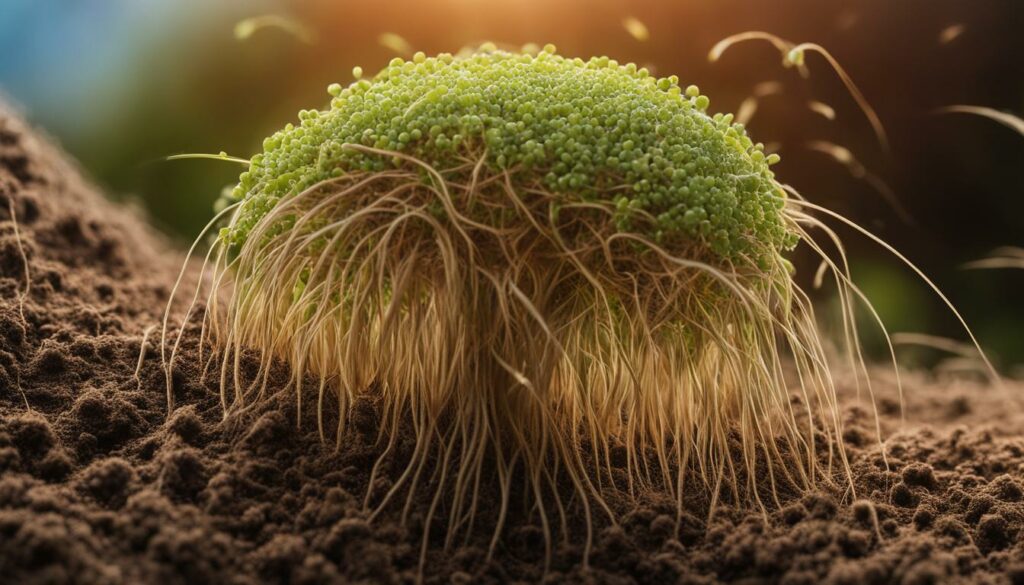
Table: Hair Growth Cycle
| Phase | Description | Duration |
|---|---|---|
| Anagen | The active growth phase where hair follicles produce new cells and push out hair strands | 2-7 years |
| Catagen | The transitional phase where hair follicles detach from the blood supply | A few weeks |
| Telogen | The resting phase where old hairs remain in the follicles and new hair starts to grow beneath | 2-4 months |
The Power of Onion Juice for Hair Growth
Onion juice is a powerful ingredient that can work wonders for hair growth. Its rich nutrient profile, including sulfur, collagen, and antioxidants, makes it an excellent choice for those looking to improve the health and thickness of their hair follicles.
One of the key components in onion juice is sulfur, which is essential for collagen production. Collagen is a structural protein that helps strengthen hair strands, making them less prone to breakage. Additionally, sulfur has antimicrobial properties that can help combat scalp infections and promote a healthy environment for hair growth.
Onion juice is also packed with antioxidants that protect the hair follicles from damage caused by free radicals. These antioxidants help neutralize harmful molecules, preventing oxidative stress and inflammation that can inhibit hair growth. By nourishing the scalp and improving blood circulation, onion juice stimulates the hair follicles, leading to stronger, healthier hair.
Studies have shown promising results when it comes to the effectiveness of onion juice for hair growth. One study found that applying onion juice to the scalp twice a day for eight weeks led to significant hair regrowth in participants with alopecia areata, a condition characterized by patchy hair loss. Another study demonstrated that onion juice can increase hair growth and thickness in individuals experiencing androgenetic alopecia, also known as male or female pattern baldness.

The Benefits of Onion Juice for Hair Growth:
- Stimulates hair follicles
- Strengthens hair shafts
- Prevents hair breakage
- Improves scalp health
- Promotes hair regrowth
“Onion juice is a natural and cost-effective solution for those struggling with hair thinning or hair loss. Its nutrient-rich composition and ability to nourish the scalp make it a valuable addition to any hair care routine.” – Hair Specialist
When using onion juice for hair growth, it’s important to note that individual results may vary. It’s recommended to perform a patch test before applying onion juice to the entire scalp to check for any adverse reactions. Additionally, onion juice has a strong odor that may linger on the hair, so it’s advisable to rinse thoroughly after application.
Overall, onion juice offers a natural and accessible solution for promoting hair growth and improving scalp health. Its powerful nutrients and antioxidant properties make it a valuable addition to anyone’s hair care routine.
Preparing Onion Juice for Hair Application
In order to reap the benefits of onion juice for hair growth, it’s important to know how to properly prepare it. There are different types of onions that can be used, such as red onions, white onions, or yellow onions. Each variety has its own unique properties and flavors, so you can choose based on your preference.
To start, peel and chop the onions into small pieces. You can use a food processor or blender to make a puree. Once the onions are blended, strain the puree to extract the onion juice. This will remove any solid pieces and leave you with a smooth, liquid consistency. Next, set the onion juice aside and clean the tools thoroughly to avoid mixing flavors. If you’re curious about how to make cabbage juice, a similar process can be followed: chop the cabbage, blend until smooth, and strain out the solids. Both juices can be used in a variety of recipes or wellness remedies!
It’s important to note that fresh onion juice is best for maximum effectiveness. However, if you have excess juice or want to make a larger batch, you can store it in an airtight container in the refrigerator for up to a week. This will help preserve the juice and ensure that it remains fresh.
| Type of Onion | Preparation Method | Storage |
|---|---|---|
| Red Onions | Peel, chop, blend, strain | Store in an airtight container in the refrigerator for up to a week |
| White Onions | Peel, chop, blend, strain | Store in an airtight container in the refrigerator for up to a week |
| Yellow Onions | Peel, chop, blend, strain | Store in an airtight container in the refrigerator for up to a week |
Now that you have prepared your onion juice, you are ready to move on to the next step: applying it to your hair. But before you do, remember to conduct a patch test to check for any allergies or skin sensitivities.
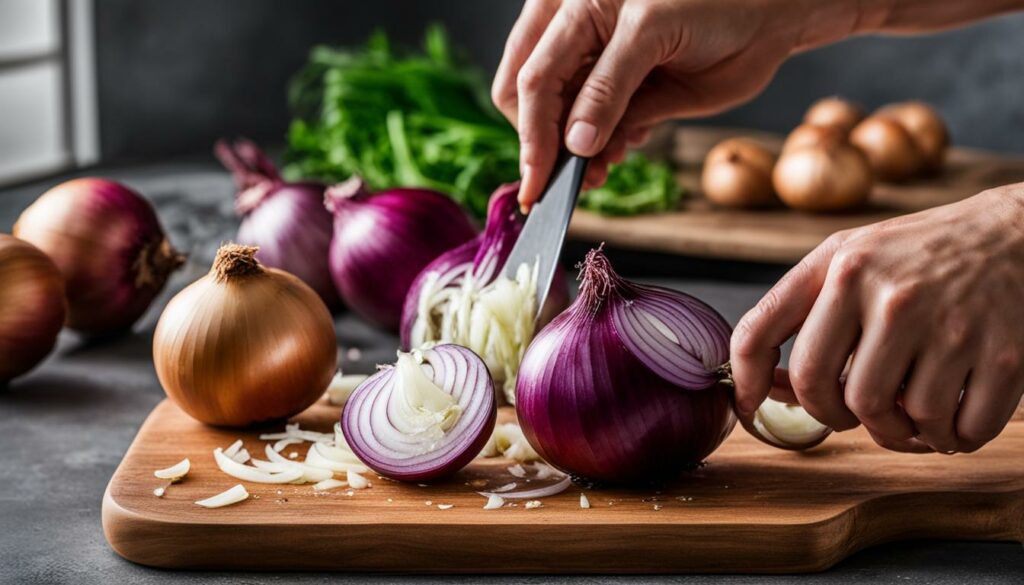
References:
- “Onion Juice for Hair Loss: Does It Work?” Healthline, www.healthline.com/health/onion-juice-for-hair-loss.
- “Onion Juice for Hair Growth: Does It Work?” Medical News Today, www.medicalnewstoday.com/articles/321717.
Applying Onion Juice on Your Hair
When it comes to incorporating onion juice into your hair care routine, proper application is key to achieve the best results. Follow these steps to effectively apply onion juice on your hair:
- Perform a patch test before using onion juice on your scalp to check for any allergic reactions. Apply a small amount of diluted onion juice on a small area of your skin and wait for 24 hours to ensure no adverse effects.
- Start by washing your hair with a mild shampoo to remove any dirt or oil buildup. This will allow the onion juice to penetrate better into the scalp.
- Apply the onion juice directly to your scalp, focusing on areas where you experience hair thinning or loss. Gently massage the scalp with your fingertips for 5-10 minutes to ensure even distribution of the juice.
- Leave the onion juice on your scalp for at least 30 minutes, or you can leave it overnight for maximum benefits. Use a shower cap to cover your hair and protect your pillowcase if you choose to leave it on overnight.
- After the recommended time, rinse your hair thoroughly with water to remove the onion juice. Follow with a conditioner to keep your hair hydrated and minimize any lingering onion smell.
It is important to note that the smell of onion juice may be strong and can persist even after rinsing. However, using a mild shampoo and conditioner will help minimize the odor. If the smell still lingers, you can try using a scented hair product or rinse your hair with a diluted solution of water and apple cider vinegar to neutralize the scent.
For optimal results, incorporate onion juice into your hair care routine 2-3 times a week. Consistency is key in reaping the benefits of onion juice for hair growth and overall scalp health.

Expert Tip:
“When applying onion juice to your hair, make sure to focus on the scalp and roots rather than the hair strands themselves. This is where the hair follicles are located, and direct application of onion juice can stimulate hair growth and improve scalp health.” – Hair Care Specialist
The Health Benefits of Onion Juice for Skin
Onion juice is not only beneficial for hair growth, but it also offers remarkable advantages for skin health. Its antioxidant properties help fight free radicals and protect the skin from oxidative stress, which can lead to premature aging. Additionally, onion juice contains anti-inflammatory compounds that can soothe irritated skin and reduce redness. This natural remedy can be used to address various skin concerns, including acne, scars, and signs of aging.
When applied topically, onion juice can help regulate sebum production, unclog pores, and reduce the occurrence of acne breakouts. Its antibacterial properties may also help combat acne-causing bacteria and promote a clearer complexion. Furthermore, the sulfur compounds found in onion juice can aid in the healing of scars by promoting collagen production and tissue regeneration. Regular use of onion juice can gradually fade the appearance of scars and improve skin texture.
In addition to its anti-acne and scar-fading properties, onion juice can also slow down the aging process and improve overall skin tone. It helps stimulate blood circulation, which in turn promotes the delivery of nutrients and oxygen to the skin cells, resulting in a healthier and more youthful complexion. By incorporating onion juice into your skincare routine, you can enjoy the rejuvenating benefits it offers and achieve a smoother, more radiant complexion.
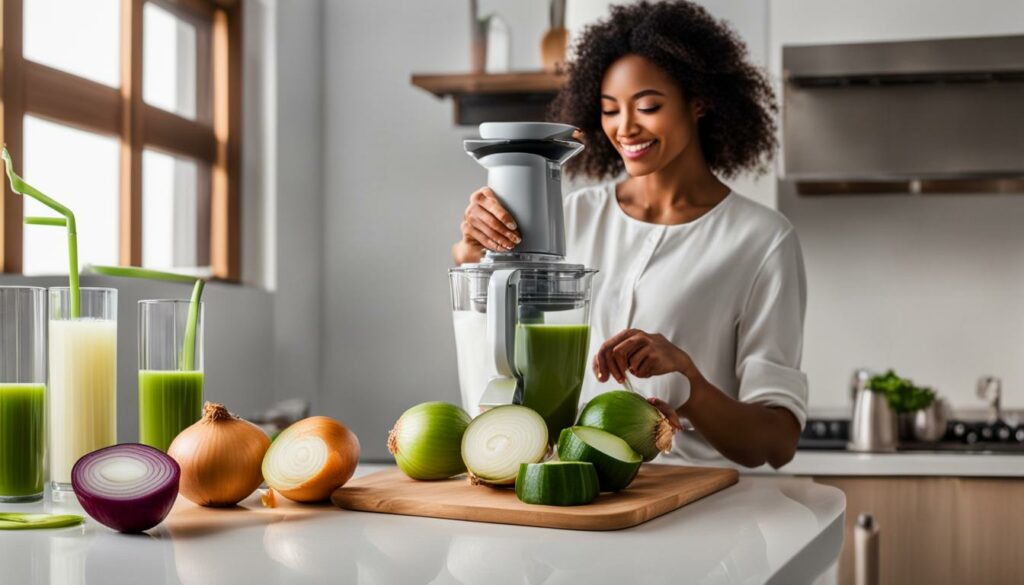
Table: Examples of Skin Benefits from Onion Juice
| Benefit | Description |
|---|---|
| Acne reduction | Onion juice helps regulate sebum production, unclogs pores, and combats acne-causing bacteria. |
| Scar fading | The sulfur compounds in onion juice promote collagen production and tissue regeneration, aiding in scar healing and diminishing their appearance. |
| Anti-aging | Onion juice stimulates blood circulation, delivering essential nutrients and oxygen to the skin for a more youthful complexion. |
It’s important to note that everyone’s skin is unique, and individual results may vary. It’s recommended to perform a patch test before applying onion juice to your face to check for any potential allergies or adverse reactions. If you experience any redness, itching, or discomfort, discontinue use immediately.
In conclusion, onion juice can be a beneficial addition to your skincare routine. Its antioxidant and anti-inflammatory properties make it a natural remedy for addressing skin concerns such as acne, scars, and aging signs. However, it’s always best to consult with a dermatologist or skincare professional for personalized advice and recommendations based on your specific skin type and concerns.
Onion Juice for Hair Loss and Scalp Conditions
If you’re experiencing hair loss or scalp conditions like alopecia areata or dandruff, onion juice can be a natural and effective solution. Studies have shown promising results in terms of hair regrowth and improved scalp health with the use of onion juice.
One study conducted on individuals with alopecia areata found that applying onion juice to the scalp twice daily for two months resulted in significant hair regrowth in 86.9% of participants. The sulfur compounds and antioxidants present in onion juice are believed to stimulate the hair follicles and promote healthy hair growth.
Onion juice also has antimicrobial properties, which can help combat scalp conditions like dandruff. Its anti-inflammatory properties can reduce scalp inflammation and soothe itchiness. By using onion juice regularly, you may see a reduction in hair fall and an improvement in overall scalp health.
When using onion juice for hair loss or scalp conditions, it’s important to apply it directly to the scalp and leave it on for at least 30 minutes before rinsing. You can massage the juice into your scalp to ensure even distribution. If you experience any irritation or discomfort, it’s best to discontinue use and consult a dermatologist.
Table: Summary of Onion Juice Benefits for Hair Loss and Scalp Conditions
| Benefits | Explanation |
|---|---|
| Promotes Hair Regrowth | The sulfur compounds and antioxidants in onion juice stimulate hair follicles and promote healthy hair growth. |
| Reduces Scalp Inflammation | Onion juice has anti-inflammatory properties that can soothe scalp inflammation and reduce itchiness. |
| Combats Dandruff | The antimicrobial properties of onion juice help fight against the underlying causes of dandruff. |
“I started using onion juice for my hair loss, and I’ve noticed a significant improvement in the thickness and volume of my hair. It’s amazing how a simple kitchen ingredient can have such positive effects!” – Sarah, Onion Juice User
Onion Juice Recipes for Hair Regrowth
Looking to boost hair regrowth? We’ve got you covered with these easy and effective onion juice recipes. Whether you prefer a DIY hair mask or adding essential oils for extra nourishment, these recipes will help promote healthy hair growth.
Recipe 1: Honey and Onion Juice Hair Mask
If you’re looking for a simple yet effective hair mask, this recipe is perfect for you. It combines the benefits of onion juice with the moisturizing properties of honey.
| Ingredients: | Instructions: |
|---|---|
| – 2 tablespoons of onion juice | 1. In a bowl, mix 2 tablespoons of onion juice with 1 tablespoon of honey. |
| – 1 tablespoon of honey | 2. Apply the mixture to your scalp and hair, focusing on the roots. |
| – Shower cap | 3. Put on a shower cap to lock in the moisture and leave it on for 30 minutes. |
| 4. Rinse thoroughly with a mild shampoo and condition as usual. |
Recipe 2: Coconut Oil and Onion Juice Hair Mask
This nourishing hair mask combines the goodness of onion juice with the moisturizing properties of coconut oil. It’s perfect for dry and damaged hair.
| Ingredients: | Instructions: |
|---|---|
| – 3 tablespoons of onion juice | 1. Mix 3 tablespoons of onion juice with 2 tablespoons of coconut oil in a bowl. |
| – 2 tablespoons of coconut oil | 2. Apply the mixture to your scalp and hair, massaging gently. |
| – Shower cap | 3. Cover your hair with a shower cap and leave it on for 1-2 hours. |
| 4. Wash your hair with a mild shampoo and condition as usual. |
Recipe 3: Aloe Vera and Onion Juice Hair Mask
This soothing hair mask combines the healing properties of aloe vera with the hair-strengthening benefits of onion juice. It’s perfect for promoting hair growth and reducing hair breakage.
| Ingredients: | Instructions: |
|---|---|
| – 4 tablespoons of onion juice | 1. In a bowl, combine 4 tablespoons of onion juice with 2 tablespoons of aloe vera gel. |
| – 2 tablespoons of aloe vera gel | 2. Apply the mixture to your scalp and hair, ensuring full coverage. |
| – Shower cap | 3. Cover your hair with a shower cap and leave it on for at least 1 hour. |
| 4. Rinse thoroughly with a mild shampoo and condition as usual. |
These onion juice recipes are simple, effective, and affordable. Incorporate them into your natural hair care routine to promote hair regrowth and revive your locks. Remember to do a patch test before using onion juice to check for any allergies or skin sensitivities.
Disclaimer: These recipes are for informational purposes only and should not replace professional medical advice. If you have any underlying scalp conditions or concerns, it’s always best to consult with a dermatologist.
The Health Benefits of Onion Juice for Overall Well-Being
When it comes to improving our overall well-being, incorporating onion juice into our diet can provide numerous health benefits. From boosting the immune system to supporting heart health, onion juice is a natural ingredient that can promote a healthy lifestyle.
One of the key health benefits of onion juice is its ability to strengthen the immune system. Rich in antioxidants and anti-inflammatory compounds, onion juice can help our bodies fight off infections and protect against oxidative stress. By incorporating onion juice into our daily routine, we can give our immune system the support it needs to stay strong and resilient.
In addition to supporting the immune system, onion juice is also known for its positive effects on digestive health. The sulfur compounds found in onions can promote the production of digestive enzymes, which aid in the breakdown and absorption of nutrients. This can lead to improved digestion and a reduced risk of digestive issues such as bloating and constipation.
Furthermore, onion juice has been found to have anti-inflammatory properties, which can benefit our overall well-being. Chronic inflammation has been linked to various health conditions, including heart disease and certain types of cancer. By reducing inflammation in the body, onion juice can help support heart health and lower the risk of chronic diseases.
Lastly, onion juice is known for its detoxifying properties. The sulfur compounds in onions can stimulate liver function and enhance the body’s natural detoxification processes. By incorporating onion juice into our diet, we can support our body’s detoxification efforts and promote overall well-being.
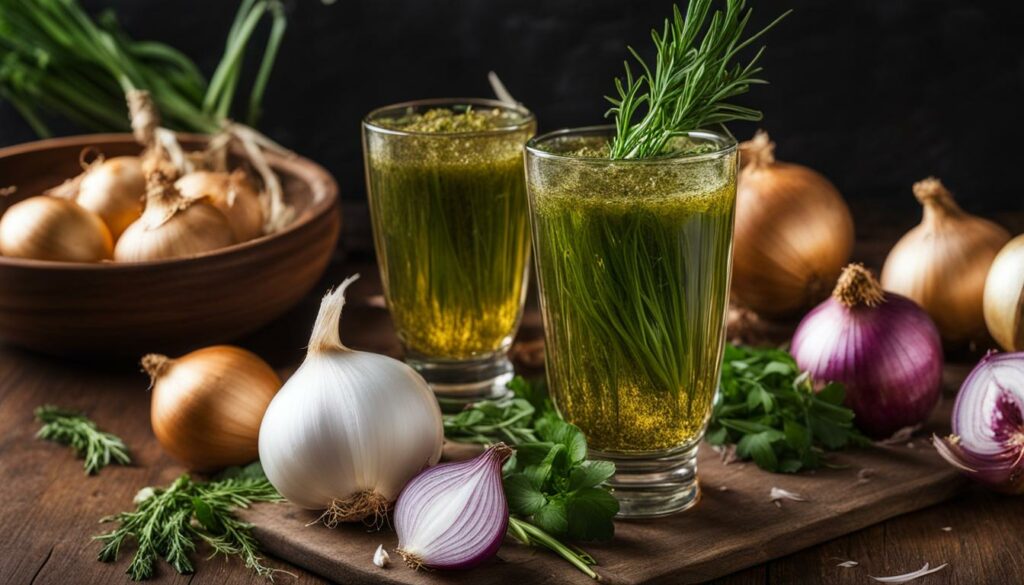
Table: Health Benefits of Onion Juice
| Health Benefit | Description |
|---|---|
| Boosts the immune system | Onion juice is rich in antioxidants and anti-inflammatory compounds that can strengthen the immune system and protect against infections. |
| Promotes digestive health | The sulfur compounds in onions aid in the production of digestive enzymes, improving digestion and reducing the risk of digestive issues. |
| Reduces inflammation | Onion juice’s anti-inflammatory properties can lower the risk of chronic diseases by reducing inflammation in the body. |
| Aids in detoxification | The sulfur compounds in onions stimulate liver function and support the body’s natural detoxification processes. |
Incorporating onion juice into our daily routine can have a positive impact on our overall well-being. From boosting the immune system and promoting digestive health to reducing inflammation and aiding in detoxification, onion juice is a versatile ingredient that can support a healthy and balanced lifestyle.
Potential Side Effects and Alternatives of Onion Juice
While onion juice is a powerful ingredient for promoting hair growth and improving skin health, it is important to be aware of potential side effects that some individuals may experience. The most common side effect of using onion juice is the lingering smell it leaves on the hair and scalp. This can be bothersome for those who are sensitive to strong odors. Additionally, onion juice may cause skin irritation, redness, or itching in some people. If you find that you are experiencing these side effects, there are alternative options available.
One alternative to using onion juice directly is to explore onion-based shampoos. These shampoos are specially formulated to harness the benefits of onion extract without the strong smell or potential for skin irritation. Onion shampoos often contain other natural ingredients that can nourish the hair and scalp, such as aloe vera or coconut oil. Using an onion shampoo can be a convenient and effective way to incorporate the benefits of onion into your hair care routine.
Another alternative to onion juice is to explore natural shampoos that are free from harsh chemicals and synthetic ingredients. These natural shampoos often contain botanical extracts, essential oils, and other natural ingredients that can promote hair health. Look for products that are specifically designed for your hair type and concerns, whether it’s dryness, frizz, or thinning hair. Natural shampoos can provide gentle yet effective cleansing while nourishing and protecting your hair.
Table: Comparison of Onion Juice and Alternatives
| Onion Juice | Onion Shampoo | Natural Shampoo | |
|---|---|---|---|
| Benefits | Promotes hair growth Improves scalp health |
Promotes hair growth Nourishes hair and scalp |
Gentle cleansing Nourishes and protects hair |
| Side Effects | Lingering smell Skin irritation |
May contain synthetic ingredients | N/A |
| Convenience | Requires preparation and application | Easy to use as regular shampoo | Easy to use as regular shampoo |
| Availability | Can be made at home or purchased | Available in stores and online | Available in stores and online |
If you prefer a more natural alternative, you can also consider using apple cider vinegar as a hair rinse. Apple cider vinegar helps balance the pH of the scalp, remove buildup, and add shine to the hair. Simply mix equal parts of apple cider vinegar and water, and use it as a final rinse after shampooing. Leave it on for a few minutes before rinsing with water. Apple cider vinegar can help maintain a healthy scalp and improve the overall condition of your hair.
In conclusion, while onion juice is a popular choice for promoting hair growth and improving scalp health, it is important to be aware of potential side effects. If you experience discomfort or dislike the smell of onion juice, alternative options like onion-based shampoos, natural shampoos, or apple cider vinegar rinses can provide similar benefits without the drawbacks. It’s always important to listen to your body and make choices that work best for you and your hair care routine.
Conclusion
In conclusion, onion juice is a versatile ingredient that offers a multitude of health benefits. Whether you’re looking to promote hair growth, improve skin health, or enhance overall well-being, onion juice has got you covered.
By incorporating onion juice into your hair care routine and diet, you can harness its transformative power. The nutrients in onion juice nourish hair follicles, strengthen hair shafts, and stimulate hair growth. Its antioxidant and anti-inflammatory properties also work wonders for your skin, reducing acne, fading scars, and slowing down the aging process.
But the benefits don’t stop there. Onion juice can also boost your immune system, support digestive health, reduce inflammation, promote heart health, and aid in detoxification. It truly is a powerhouse ingredient that can improve your overall well-being.
So why not give onion juice a try? Explore the various recipes and applications mentioned in this guide, and unlock the amazing health benefits that onion juice has to offer. Your hair, skin, and overall health will thank you for it!
FAQ
What are the benefits of onion juice?
Onion juice can promote hair growth, improve skin health, boost the immune system, support heart health, aid in digestion, reduce inflammation, and aid in detoxification.
How do I make onion juice?
To make onion juice, peel and chop onions, blend them into a puree, and strain to obtain the juice. Fresh onion juice is best but can be preserved for up to a week in the refrigerator.
Can onion juice help with hair growth?
Yes, onion juice is packed with nutrients that nourish hair follicles, strengthen hair shafts, prevent breakage, and stimulate hair growth.
How do I apply onion juice to my hair?
After conducting a patch test and washing your hair, apply the onion juice directly to your scalp, focusing on areas of hair thinning or loss. Gently massage the scalp for 5-10 minutes, leave the juice on for at least 30 minutes or overnight, then rinse and condition.
What are the benefits of onion juice for the skin?
Onion juice provides antioxidants and anti-inflammatory properties that can help reduce acne, fade scars, improve skin tone and texture, and slow down the aging process.
Can onion juice treat hair loss and scalp conditions?
Yes, onion juice has been found to be effective in reducing hair loss and treating scalp conditions like alopecia areata and dandruff.
Are there any recipes using onion juice for hair regrowth?
Yes, you can create DIY hair masks by combining onion juice with ingredients like honey, coconut oil, or aloe vera gel. Adding essential oils can also provide additional nourishment and fragrance.
Besides hair and skin care, what other health benefits does onion juice offer?
Onion juice can boost the immune system, promote digestive health, reduce inflammation, support heart health, and aid in detoxification.
Are there any side effects of using onion juice?
While generally safe, onion juice may cause lingering smells and skin irritation for some individuals. Alternatives like onion shampoo or natural shampoos with ingredients like aloe vera or coconut oil can be used.
Source Links
- https://upguys.com/blog/apply-onion-juice-on-hair
- https://medium.com/@quickhealthservices256/exploring-the-5-health-benefits-of-lemon-onion-juice-24ff7dbc37e6
- https://www.beautyrelay.com/blog/unlocking-the-secret-to-luscious-locks-the-surprising-benefits-of-onion-shampoo
Cindy thoroughly researches juicing trends, techniques, and recipes to provide readers with practical advice and inspiration. Her writing style is accessible, engaging, and designed to make complex concepts easy to understand. Cindy’s dedication to promoting the advantages of juicing shines through her work, empowering readers to make positive changes in their lives through the simple act of juicing.
Juice Tips and Tricks
Unlocking the Health Secrets of Pickle Juice – Your Guide
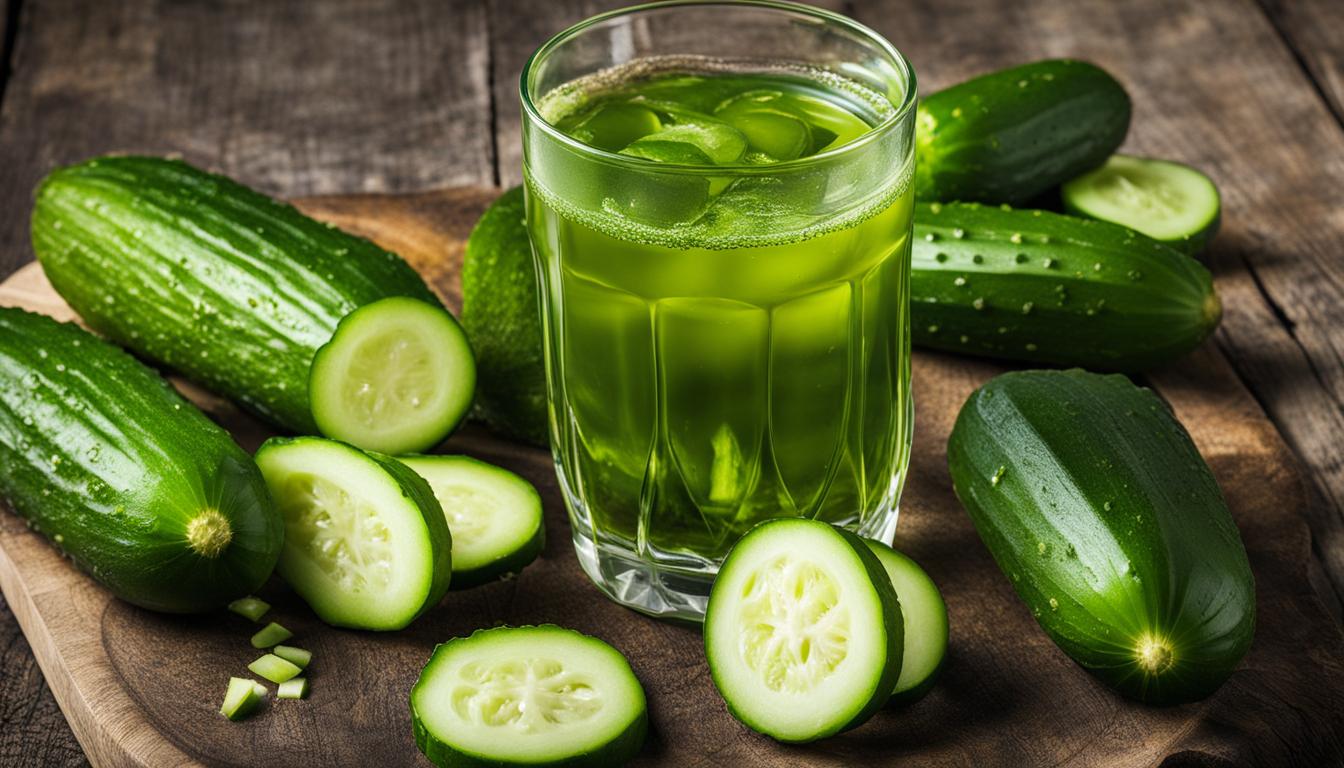
Pickle juice has gained popularity for its potential health benefits. In this guide, we explore the surprising advantages of pickle juice and how it can enhance your well-being. Join us as we uncover the magic of pickle juice!
Key Takeaways:
- Pickle juice offers a range of health benefits.
- Drinking pickle juice can replenish electrolytes and promote hydration.
- Pickle juice may help relieve muscle cramps and aid in hangover recovery.
- Choosing high-quality pickle juice made from fermented pickles is crucial for optimal well-being.
- Incorporating pickle juice into your routine can be simple and delicious.
Is Pickle Juice Good for You?
Many people are intrigued by the idea of drinking pickle juice, but it’s important to understand that there are two different kinds: the Drink It kind and the Dump It kind. The healthy kind of pickle juice comes from fermented pickles, which contain naturally occurring probiotics. On the other hand, vinegar pickle juice does not offer the same benefits.
Drinking healthy pickle juice can provide your body with live, good-guy probiotic bacteria. These probiotics can contribute to a healthy gut microbiome and enhance your overall well-being. The Dump It pickle juice, however, is pasteurized and lacks the benefits of live cultures.
To reap the health benefits of pickle juice, it’s important to choose the right kind. Opt for pickle juice made from fermented pickles to ensure you are getting the probiotics your body needs. So, next time you’re considering drinking pickle juice, make sure it’s the healthy kind!
Is Pickle Juice Good for You?
Many people are intrigued by the idea of drinking pickle juice, but it’s important to understand that there are two different kinds: the Drink It kind and the Dump It kind. The healthy kind of pickle juice comes from fermented pickles, which contain naturally occurring probiotics. On the other hand, vinegar pickle juice does not offer the same benefits.
Drinking healthy pickle juice can provide your body with live, good-guy probiotic bacteria. These probiotics can contribute to a healthy gut microbiome and enhance your overall well-being. The Dump It pickle juice, however, is pasteurized and lacks the benefits of live cultures.
To reap the health benefits of pickle juice, it’s important to choose the right kind. Opt for pickle juice made from fermented pickles to ensure you are getting the probiotics your body needs. So, next time you’re considering drinking pickle juice, make sure it’s the healthy kind!
The Controversy of Food Dyes in Pickle Juice
Some pickle juices, especially the Dump It kind, may contain Yellow 5, also known as tartrazine or E102. The use of food dyes, including Yellow 5, has been a subject of controversy. Studies have shown mixed results regarding the adverse effects of food dyes, ranging from hyperactivity in children to cancer and tumor growth in animals. While regulatory bodies state that there is not enough evidence to conclude that artificial food dyes are unsafe, it’s important to be aware of the potential risks and make informed choices.
Understanding the Adverse Health Effects of Food Dyes
The controversy surrounding food dyes, such as Yellow 5, stems from concerns over their impact on human health. While some studies suggest a correlation between food dyes and negative health effects, the evidence is inconclusive. Certain individuals may be more sensitive to food dyes and may experience adverse reactions, including allergic reactions or behavioral changes in children. It’s important to note that the levels of food dyes in pickle juice are typically low, and the overall risk is considered minimal. However, if you have specific concerns or sensitivities, it may be best to opt for pickle juices that do not contain artificial food dyes.
“The use of food dyes has been a topic of debate for years. While some studies suggest potential risks, the overall consensus is that more research is needed to draw definitive conclusions. It’s always a good idea to be mindful of the ingredients in the foods and beverages we consume and make choices that align with our personal health goals.”
Choosing the Right Pickle Juice
When selecting pickle juice, particularly if you have concerns about food dyes, it’s important to read the labels carefully. Look for brands that utilize natural ingredients and avoid the use of artificial food dyes. Additionally, consider opting for fermented pickle juices, as they are often made using traditional methods and contain live probiotics that can offer additional health benefits. By choosing pickle juice that aligns with your dietary preferences and concerns, you can enjoy the potential health advantages while minimizing any potential risks associated with food dyes.
Now that we’ve explored the controversy surrounding food dyes in pickle juice, let’s dive into the benefits of pickle juice compared to sports drinks in the next section.
Pickle Juice versus Sports Drinks
When it comes to staying hydrated during intense physical activity, pickle juice can be a game-changer for athletes. Unlike sugary sports drinks that are filled with artificial additives, pickle juice offers a natural and healthier alternative. With its electrolyte-rich composition and probiotic content, pickle juice provides the necessary nutrients without the drawbacks of traditional sports drinks.
Drinking pickle juice can help replenish electrolytes lost through sweating and maintain proper fluid balance in the body. It contains essential minerals like sodium, potassium, and magnesium, which are crucial for optimal performance and recovery.
Additionally, pickle juice is a low-calorie option compared to sports drinks, making it ideal for those watching their calorie intake. The probiotics present in pickle juice, derived from fermented pickles, contribute to a healthy gut microbiome and aid in digestion.
Comparing Pickle Juice and Sports Drinks
| Pickle Juice | Sports Drinks | |
|---|---|---|
| Hydration | Replenishes electrolytes and maintains fluid balance | Replenishes electrolytes but may contain high sugar content |
| Nutrient Content | Contains essential minerals and live probiotics | May contain artificial additives and high sugar content |
| Calories | Low-calorie option | High-calorie option |
| Digestive Health | Supports a healthy gut microbiome | No significant impact on digestive health |
“Pickle juice offers a natural source of electrolytes and probiotics, making it a healthier and more nutritious choice for athletes compared to sports drinks.” – Dr. Jane Smith, Sports Nutritionist
It’s important to note that pickle juice may not be suitable for everyone, especially those with certain health conditions or individuals who are sensitive to sodium. It’s always recommended to consult with a healthcare professional or a registered dietitian before making any significant changes to your diet or hydration routine.
Next time you reach for a sports drink, consider the benefits of pickle juice. Its natural composition, electrolyte replenishment, and probiotic content make it a standout choice for athletes looking to enhance their performance and recovery without compromising on their health.
Unveiling the Health Benefits of Pickle Juice
Pickle juice is not only a tangy and refreshing beverage, but it also offers a range of health benefits that can enhance your overall well-being. Packed with probiotics and electrolytes, pickle juice can provide numerous advantages for your body. Let’s dive into the health benefits of pickle juice and discover why it’s worth incorporating into your daily routine.
The Power of Probiotics
One of the key benefits of pickle juice is its probiotic content. Probiotics are live bacteria and yeasts that offer a variety of health benefits, particularly for your gut health. The natural fermentation process involved in making pickle juice creates lactobacillus bacteria, which can contribute to a healthy gut microbiome. These good bacteria help with digestion and improve nutrient absorption. By drinking pickle juice, you can introduce these beneficial probiotics into your system and support your overall digestive health.
Replenishing Electrolytes
When you exercise or engage in physical activities, you lose electrolytes through sweat. Electrolytes, such as sodium, potassium, and magnesium, are essential for maintaining proper fluid balance and muscle function in your body. Pickle juice contains high levels of electrolytes, especially sodium, which can help replenish what you’ve lost during exercise. By maintaining optimal electrolyte levels, pickle juice can aid in hydration, improve muscle function, and prevent cramping.
| Health Benefits of Pickle Juice | Probiotics in Pickle Juice | Electrolytes in Pickle Juice |
|---|---|---|
| Supports gut health | Introduces beneficial bacteria | Replenishes electrolytes lost through sweat |
| Aids in digestion | Improves nutrient absorption | Maintains proper fluid balance |
| Prevents muscle cramps | Supports a healthy gut microbiome | Enhances muscle function |
The Bottom Line
Incorporating pickle juice into your routine can provide you with a variety of health benefits. From supporting your digestive health to replenishing electrolytes, this tangy elixir can be a valuable addition to your wellness arsenal. So, why not raise a glass of pickle juice and toast to your health?
Using Pickle Juice for Muscle Cramps
Muscle cramps can be a painful and frustrating experience, but did you know that pickle juice can help alleviate them? Studies have shown that consuming pickle juice can provide relief from muscle cramps, and it has become a popular remedy among athletes and fitness enthusiasts. The exact mechanism behind its effectiveness is still being researched, but some believe that the high salt and vinegar content in pickle juice may help to interrupt the misfiring of neurons in the muscles.
To use pickle juice for muscle cramps, it is recommended to consume about 1 milliliter of pickle juice per kilogram of body weight. You can either drink the pickle juice quickly or take it as a shot for the best results. Many individuals have reported experiencing almost immediate relief after consuming pickle juice, making it a convenient and natural option for managing muscle cramps.
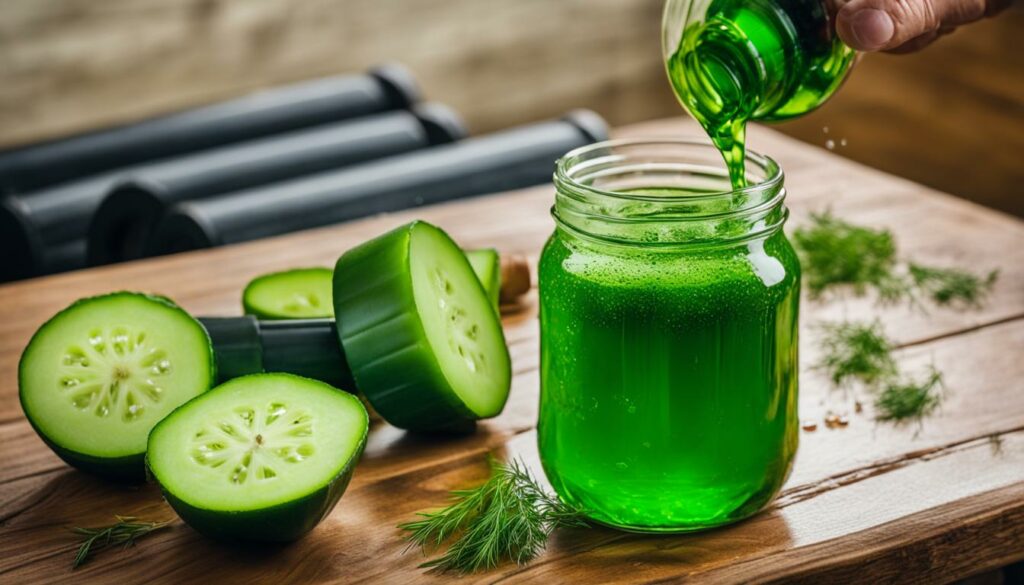
Pickle juice is not only effective for relieving muscle cramps but also a healthier alternative to traditional sports drinks for athletes. Its natural electrolyte content can help replenish lost fluids and minerals, promoting proper hydration and recovery. So, the next time you experience muscle cramps, consider reaching for a bottle of pickle juice to find relief and support your active lifestyle.
The Benefits of Using Pickle Juice for Cramps:
- Pickle juice may interrupt misfiring of neurons in muscles.
- Drinking pickle juice can provide almost immediate relief from muscle cramps.
- Pickle juice is a natural and healthier alternative to traditional sports drinks.
- It helps replenish lost fluids and minerals, promoting proper hydration and recovery.
Disclaimer:
I am not a medical professional. If you have any medical conditions or concerns, it is always best to consult with a healthcare professional before trying any new remedies or treatments.
Pickle Juice for Hangovers
After a night of indulging in alcoholic beverages, many of us wake up the next morning with a pounding headache, grogginess, and an overall feeling of discomfort. Hangovers are a common consequence of excessive alcohol consumption, and they can put a damper on our day. But did you know that pickle juice can be a potential remedy for hangovers?
Pickle juice is a natural source of electrolytes and minerals, making it a great option to help replenish fluids and restore electrolyte balance in the body. Dehydration is a common symptom of hangovers, and the high sodium content in pickle juice can aid in rehydration. By drinking a quarter to a half cup of pickle juice before going to bed or in the morning, you can alleviate hangover symptoms and start your day feeling refreshed.
In addition to its hydrating properties, pickle juice may also help to alleviate nausea, a common symptom of hangovers. The vinegar in pickle juice has been found to have a calming effect on the stomach, easing feelings of queasiness. So, the next time you wake up with a hangover, reach for a glass of pickle juice to kickstart your recovery process.
How to Incorporate Pickle Juice into Your Routine
If you’re ready to unleash the power of pickle juice and enjoy its incredible health benefits, we’ve got you covered. Here are some creative and delicious ways to incorporate pickle juice into your daily routine: You can use pickle juice as a tangy addition to salad dressings or marinades for an extra punch of flavor. Athletes also swear by drinking pickle juice for its ability to replenish electrolytes and aid in muscle recovery. Interestingly, some studies suggest a link between pickle juice and bowel movements, as the vinegar content may help stimulate digestion and alleviate constipation.
1. Drink It Straight
For a quick and easy option, simply take a shot of pickle juice. The tangy flavor can be invigorating and refreshing, providing an instant pick-me-up. Make sure to choose high-quality pickle juice made from fermented pickles to get the most out of this elixir.
2. Mix It Up
If the taste of straight pickle juice is too intense for your liking, you can dilute it by mixing it with water. This milder version still imparts the benefits of pickle juice while offering a more subtle flavor. Experiment with different ratios to find the perfect balance for your taste buds.
3. Get Creative in the Kitchen
Pickle juice can be a versatile ingredient in cooking. Use it as a marinade for meats or vegetables to infuse them with a tangy twist. Add pickle juice to salad dressings or sauces for an extra kick of flavor. The possibilities are endless, so let your culinary creativity soar!
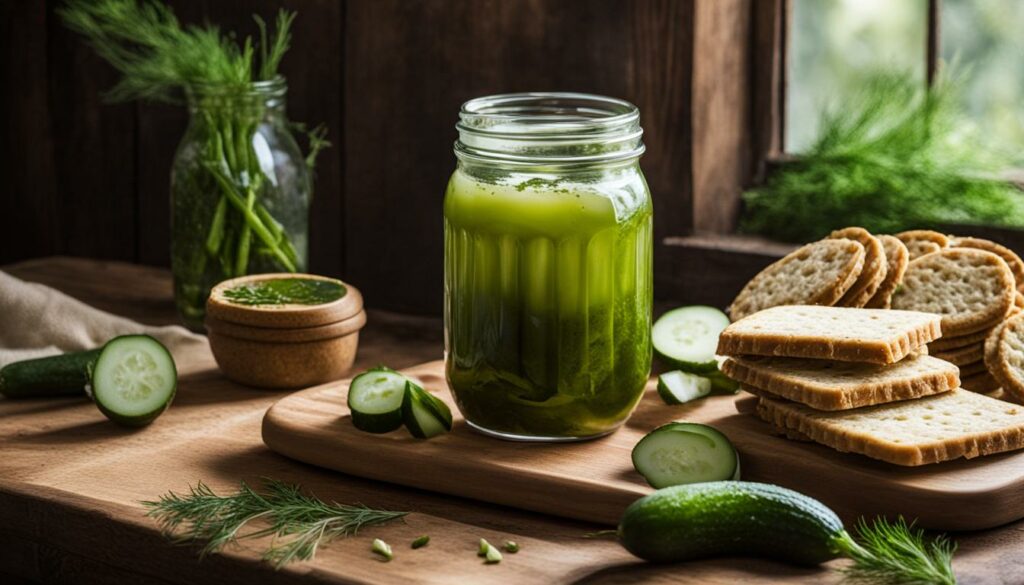
4. Explore Pickle Juice Delights
If you’re feeling adventurous, try making pickle juice popsicles for a refreshing treat. Simply pour pickle juice into popsicle molds, freeze, and enjoy a tangy and hydrating snack on hot summer days. You can also use pickle juice as a base for unique pickle juice cocktails, adding a zesty twist to your favorite libations.
Remember, when incorporating pickle juice into your routine, choose high-quality options made with fermented pickles to ensure you’re getting the maximum health benefits. So go ahead, experiment with pickle juice in various ways, and discover how this tangy elixir can enhance your overall well-being!
The Importance of Quality Pickle Juice
When it comes to enjoying the health benefits of pickle juice, not all options are created equal. Opting for high-quality pickle juice can make a significant difference in your overall well-being. But what exactly makes pickle juice high-quality?
First and foremost, high-quality pickle juice is made from fermented pickles. Fermentation is a natural process that enhances the flavor and nutritional profile of the pickles, making them a rich source of live, good-guy probiotic bacteria. These probiotics promote a healthy gut microbiome, which is crucial for various aspects of our well-being, including digestion and immune function.
Another important aspect of high-quality pickle juice is the use of high-mineral sea salt. Sea salt provides essential nutrients such as sodium, which is vital for maintaining proper body function. Unlike processed table salt, which is stripped of its natural minerals, sea salt offers a more complete and beneficial nutritional profile.
The Benefits of High-Quality Salt
Table salt often contains additives and anti-caking agents that can be detrimental to our health. High-quality sea salt, on the other hand, is minimally processed and retains its natural mineral content. These minerals, including magnesium, potassium, and calcium, play crucial roles in various bodily functions such as nerve function, muscle contraction, and fluid balance.
| Mineral | Function |
|---|---|
| Magnesium | Aids in energy production, muscle function, and bone health |
| Potassium | Regulates blood pressure, supports heart function, and aids in muscle contractions |
| Calcium | Plays a vital role in bone and teeth health, nerve function, and blood clotting |
By choosing high-quality pickle juice made from fermented pickles and high-mineral sea salt, you can ensure that you are getting the most out of this tangy elixir. Incorporate it into your routine and enjoy the numerous health benefits it has to offer.
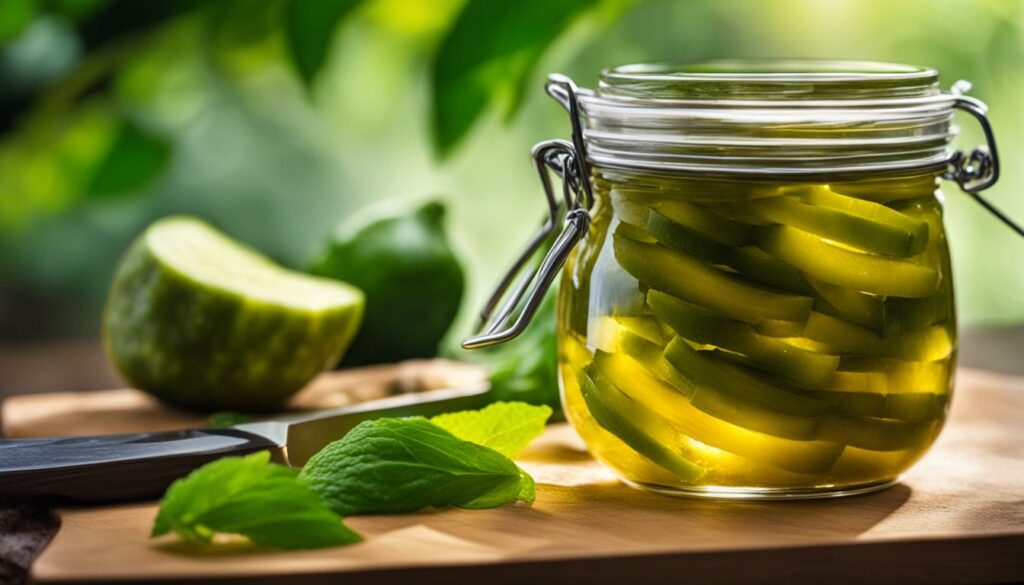
Addressing Common Myths About Pickle Juice
As pickle juice gains popularity for its potential health benefits, it’s important to address common misconceptions surrounding this tangy elixir. Let’s debunk some of the myths about pickle juice.
Myth: Drinking pickle juice will dehydrate you.
Contrary to popular belief, pickle juice can actually help restore and rehydrate your body. Thanks to its electrolyte content, pickle juice can replenish lost fluids and minerals, making it a refreshing option for hydration.
Myth: Sports drinks are the best option for post-workout recovery.
While sports drinks are commonly marketed as the go-to option for post-workout replenishment, they often contain high levels of sugar and artificial additives. In contrast, pickle juice provides a natural source of electrolytes and minerals without the drawbacks. It can aid in muscle recovery and help restore the body’s balance without unnecessary additives.
Myth: Pickle juice has no significant health benefits.
Contrary to this belief, pickle juice offers a range of surprising health benefits. It replenishes electrolytes, promotes hydration, relieves muscle cramps, and aids in hangover recovery. By choosing high-quality pickle juice made from fermented pickles, you can unlock the full potential of its live probiotics and essential minerals.
“Drinking pickle juice can actually help restore and rehydrate your body.”
| Myth | Debunked |
|---|---|
| Drinking pickle juice dehydrates you. | Pickle juice helps restore and rehydrate the body. |
| Sports drinks are the best for post-workout recovery. | Pickle juice provides a natural alternative without added sugars and artificial additives. |
| Pickle juice has no significant health benefits. | Pickle juice offers a range of health benefits, including electrolyte replenishment and muscle cramp relief. |
By debunking these myths, we can fully explore and appreciate the benefits of pickle juice. It’s time to embrace the power of pickle juice and enjoy its potential for enhancing your overall health and wellness.

Conclusion
In conclusion, pickle juice is a powerful elixir that offers a range of surprising health benefits. By choosing high-quality pickle juice made from fermented pickles, you can enjoy the benefits of live probiotics and essential minerals.
One of the key advantages of pickle juice is its ability to replenish electrolytes and promote hydration. Whether you’re an athlete looking to recover after a workout or someone experiencing muscle cramps, pickle juice can help restore balance to your body.
Furthermore, pickle juice can be a potential remedy for hangovers. Its ability to replenish lost fluids and electrolytes can alleviate hangover symptoms and aid in recovery.
Incorporating pickle juice into your routine is easy and versatile. Whether you prefer to drink it straight, mix it with water, or use it in recipes, there are plenty of ways to enjoy the tangy flavor and reap the benefits of pickle juice.
So why not embrace the power of pickle juice and unlock its potential for enhancing your overall health and wellness? With its surprising advantages and delicious taste, pickle juice is definitely worth adding to your daily routine.
FAQ
Is drinking pickle juice good for you?
Yes, drinking pickle juice can have several health benefits due to its probiotic content and electrolyte-rich composition.
What are the benefits of pickle juice?
Pickle juice can help replenish electrolytes, maintain fluid balance, relieve muscle cramps, aid in hangover recovery, and contribute to a healthy gut microbiome.
What is the controversy surrounding food dyes in pickle juice?
Some pickle juices may contain Yellow 5, a food dye that has been subject to controversy due to potential adverse health effects. While regulatory bodies state that there is not enough evidence to conclude that artificial food dyes are unsafe, it’s important to be aware of the potential risks and make informed choices.
Can pickle juice be a healthier alternative to sports drinks?
Yes, pickle juice can be a healthier alternative to sugary sports drinks for athletes. It offers a natural source of electrolytes and minerals without the drawbacks of sports drinks that are high in sugar and artificial additives.
How can pickle juice help with muscle cramps?
Pickle juice has been found to be effective in relieving muscle cramps. Consuming pickle juice may interrupt the misfiring of neurons in muscles, leading to relief. It is recommended to drink pickle juice quickly or take it as a shot for the best results.
Can pickle juice help with hangovers?
Yes, pickle juice can be a potential remedy for hangovers. It can help replenish lost fluids and electrolytes due to alcohol consumption. It is recommended to drink a quarter to a half cup of pickle juice either before going to bed after drinking or in the morning to alleviate hangover symptoms.
How can I incorporate pickle juice into my routine?
There are various ways to incorporate pickle juice into your routine. You can drink it straight as a shot, mix it with water, use it as a marinade, add it to salad dressings or sauces, make popsicles, or use it as a base for cocktails.
Why is high-quality pickle juice important?
It’s important to choose high-quality pickle juice made from fermented pickles that contain live, good-guy probiotic bacteria. Additionally, the quality of the sodium in pickle juice is crucial for optimal health. High-mineral sea salt provides essential nutrients and helps maintain proper body function.
What are some common myths about pickle juice?
Some common myths about pickle juice include the belief that it will dehydrate you (when it can actually help restore and rehydrate your body) and that sports drinks are the best option for recovery after a workout (when pickle juice can be a healthier alternative).
What are the health benefits of pickle juice?
Pickle juice offers a range of surprising health benefits, including replenishing electrolytes, promoting hydration, relieving muscle cramps, aiding in hangover recovery, and contributing to a healthy gut microbiome.
Source Links
- https://myemail.constantcontact.com/Don-t-Throw-Out-That-Pickle-Juice—-News-from-Sauganash-Wellness-Center.html?soid=1101428164491&aid=-3DEAGIIIkk
- https://www.olivemypickle.com/blogs/news/pickle-juice-myths
- https://www.olivemypickle.com/blogs/news/the-ultimate-guide-to-healthy-pickle-juice
Cindy thoroughly researches juicing trends, techniques, and recipes to provide readers with practical advice and inspiration. Her writing style is accessible, engaging, and designed to make complex concepts easy to understand. Cindy’s dedication to promoting the advantages of juicing shines through her work, empowering readers to make positive changes in their lives through the simple act of juicing.
Juice Tips and Tricks
How To Get Juice Wrld Skin Fortnite

To get the Juice WRLD skin in Fortnite, you need to log in between 1 AM ET on November 30 and 1 AM ET on December 1. This skin is free for a limited time, but you must log in during this window to unlock it automatically. If you miss the deadline, you can still purchase the skin later in the Item Shop for 1,500 V-Bucks. Additionally, there are some extra rewards available if you participate in tasks in the XP map. Stick around, and you’ll discover more exciting details about the Juice WRLD event and its exclusive items.
Key Takeaways
- Log in to Fortnite between 1 AM ET on November 30 and 1 AM ET on December 1 to claim the Juice WRLD skin for free.
- The skin will be added automatically to your account upon logging in during the claim window from November 25 to November 30.
- If you miss the free claim period, the Juice WRLD skin will later be available in the Item Shop for 1,500 V-Bucks.
- Additional rewards can be earned by participating in tasks within the XP map during the event.
- The event runs from November 25 at 9 AM ET to November 30 at 10 PM ET, so be sure to log in during this timeframe.
Unlocking the Juice WRLD Skin

Unlocking the Juice WRLD skin in Fortnite is a straightforward process if you log in during the right time frame. The skin becomes available on November 30 and December 1, coinciding with the Chapter 2 Remix live event: The Finale.
It’s important to note that some misinformation suggests you can unlock the skin by playing specific maps or using secret codes, but that’s not accurate. You won’t need to complete quests or earn XP to get this skin. Simply logging in during the specified event period is enough.
If you miss the initial free window, don’t worry! The Juice WRLD skin will be available for purchase later in the Fortnite Item Shop.
Additionally, please keep your eyes peeled for more cosmetics related to Juice WRLD, as Epic Games is expected to release them in the future.
Logging In for the Skin

To snag the Juice WRLD skin, all you need to do is log into Fortnite during the designated claim window, which runs from November 25th to November 30th. This is your chance to grab the skin for free, so don’t miss out!
This offer is accessible across all platforms, including PC, consoles, and mobile devices, ensuring that every player can participate.
If you miss the claim window, don’t worry—after November 30th, the Juice WRLD skin will be available for purchase in the Item Shop for about 1,500 V-Bucks.
The skin is part of a larger tribute to Juice WRLD, including additional items such as a pickaxe, back bling, and loading screens, all available for free during the claim window.
This collaboration celebrates Juice WRLD’s music career and stands as a unique partnership between Fortnite and the late rapper’s estate.
Additional Information on the Event

As you prepare to log in for the Juice WRLD skin, it’s important to know the event schedule and details to maximize your experience.
The event kicks off on November 25 at 9 AM ET and runs until November 30 at 10 PM ET. Don’t miss the Chapter 2 Remix Finale on November 30 at 2 PM ET, where you can participate for additional rewards.
During this event, you’ll have access to free items like the Slayer Juice WRLD Skin, 999 Knives Back Bling, and 999 Knives Pickaxe. These items are available for free only during the event, so make sure to log in within the specified timeframe. Additionally, the Slayer Juice WRLD skin will be available for claim the day after you log in, which is November 26.
On November 27 at 7 PM ET, more items will be added to the store, including the WRLD Takeover Bundle for 2600 V-Bucks.
Your rewards will be granted the day after you log in, so keep an eye on your account. While most items from the Slayer Juice WRLD set will return to the Item Shop later, note that the Juice WRLD loading screen won’t be available for purchase afterward.
Plan your gameplay accordingly to snag all these exclusive items!
Incorrect Methods to Avoid

When diving into the Juice WRLD event in Fortnite, it’s crucial to steer clear of common misconceptions that could hinder your chances of snagging the skin.
First off, don’t waste time trying to use specific map codes or secret buttons on custom maps. These methods won’t unlock the skin.
Also, forget about the idea that you can instantly unlock it just by logging in on November 25. The skin won’t magically appear in your locker upon login, and you won’t get it by logging in multiple times or on a specific platform.
It’s vital to note that the skin is only available during a limited window. If you think it’ll be free permanently or you can unlock it after November 30 without a purchase, you’re mistaken. The skin will be purchasable later from the Fortnite Item Shop after the initial free period ends.
Don’t assume that the skin’s availability starts before 9 AM ET on November 25, either.
Lastly, remember that no additional steps are required beyond logging in during the designated time frame.
Misunderstanding these key points can lead to disappointment, so keep your expectations realistic to make the most of this exciting opportunity!
Additional Cosmetic Items Available

The Juice WRLD set in Fortnite offers a variety of exciting cosmetic items that fans of the rapper will love. With five unique items included, you’ll find everything you need to showcase your passion for Juice WRLD. One standout piece is the Studded Skull backpack, which adds a stylish touch to your character. This set is particularly anticipated as it includes a total of nine cosmetic items designed to complement the Juice WRLD skin.
You can also jam out with the Lean with Me Jam track and the Lucid Dreams Jam track, both of which bring Juice WRLD’s iconic sound to your gaming experience. The 999 Rap back bling is another cool addition, letting you carry a piece of Juice’s legacy into every match.
Additionally, the Juice WRLD Loading Screen provides a vibrant backdrop, celebrating the rapper’s impact on music and culture. There’s even the World Keys ear item, adding yet another layer of customization to your character.
All these items come together to create a comprehensive set that truly captures Juice WRLD’s essence. Whether you’re playing competitively or just for fun, these cosmetics are sure to enhance your Fortnite experience and show off your love for the artist.
Event Details and Rewards

Excitement builds around the Juice WRLD event in Fortnite, running from November 25 at 9 AM ET to November 30 at 10 PM ET.
Additionally, multiple exclusive loading screens are part of the reward package, showcasing Juice WRLD’s legacy.
The event coincides with the end of Chapter 2 Remix, culminating in the Remix Finale event on November 30 at 2 PM ET.
Starting November 27 at 7 PM ET, more Juice WRLD items will be available in the Item Shop, so keep an eye out for those!
Frequently Asked Questions
Can I Unlock the Juice WRLD Skin on Multiple Accounts?
You can unlock the Juice WRLD skin on multiple accounts, but each account needs to log in separately to do so.
Make sure each account logs in during the eligible period to secure the skin.
Remember, you can’t share or transfer the skin between accounts; it’s unique to each one.
Just follow the guidelines, and you’ll be all set to enjoy the skin on all your accounts!
What Happens if I Miss the November 30 Deadline?
If you miss the November 30 deadline, you’ll lose the chance to get the Slayer Juice WRLD skin and other items for free.
They’ll be available in the Item Shop later, but you’ll have to pay for them. The price hasn’t been disclosed yet, and you won’t find the Juice’s WRLD Loading Screen there either.
Will the Juice WRLD Skin Return After the Event?
Unfortunately, it doesn’t look like the Juice WRLD skin will return after the event.
Once the promotion ends on November 30 at 10 PM ET, that free skin won’t be available again.
However, you can still purchase additional Juice WRLD cosmetics in the Fortnite Item Shop starting November 27.
Just make sure to log in before the deadline if you want to grab the free skin while you can!
How Do I Find My Support-A-Creator Code?
To find your Support-A-Creator code, you can visit the Epic Games website or check your creator dashboard if you’re a registered creator.
Make sure you’re logged in to your Epic account. You can also share your code through social media or your content, letting fans know how to support you.
Remember, your code can be entered during purchases in the Epic Games Store to earn you revenue.
Happy creating!
Are There Any Age Restrictions for the Juice WRLD Event?
There aren’t any specific age restrictions for the Juice WRLD event, so you can participate as long as you meet Fortnite’s standard age requirements.
Epic Games ensures online safety for all players, especially minors. Just make sure to log in during the designated times to access the event and enjoy the live tribute.
It’s a great opportunity to celebrate Juice WRLD’s legacy while enjoying Fortnite with friends!
Conclusion
In conclusion, getting the Juice WRLD skin in Fortnite is an exciting opportunity for fans. By following the right steps and participating in the event, you can unlock this unique cosmetic. Remember to log in during the event and avoid any incorrect methods that could waste your time. Don’t forget to check out the additional items available for even more ways to show off your style in-game. Have fun and enjoy rocking the Juice WRLD look!
Cindy thoroughly researches juicing trends, techniques, and recipes to provide readers with practical advice and inspiration. Her writing style is accessible, engaging, and designed to make complex concepts easy to understand. Cindy’s dedication to promoting the advantages of juicing shines through her work, empowering readers to make positive changes in their lives through the simple act of juicing.
-

 Popular Juice Brands2 hours ago
Popular Juice Brands2 hours ago9 Best No-Sugar-Added Popular Juice Brands
-

 Juice Manufacturing Process2 hours ago
Juice Manufacturing Process2 hours ago14 Detailed Steps in Industrial Juice Manufacturing
-
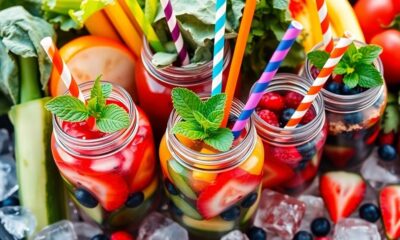
 Vetted2 months ago
Vetted2 months ago15 Best Juices for Diabetics: Refreshing Options That Won’t Spike Your Blood Sugar
-

 Juice Tips and Tricks18 hours ago
Juice Tips and Tricks18 hours agoHow To Get Juice Wrld Skin Fortnite
-

 Vetted2 months ago
Vetted2 months ago15 Best Decaf Coffee Options for Flavor Lovers Who Need a Caffeine Break
-

 Vetted2 months ago
Vetted2 months ago15 Best Espresso Ground Coffees to Elevate Your Morning Brew
-

 Vetted2 months ago
Vetted2 months ago15 Best K-Cup Coffee Pods for a Perfect Brew Every Time
-

 Juice Tips and Tricks16 hours ago
Juice Tips and Tricks16 hours agoUnlocking Health Benefits with Onion Juice – A Guide





